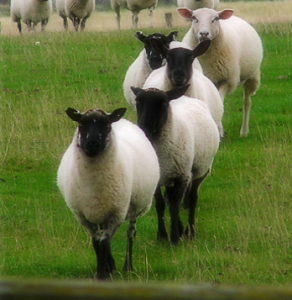Successfully Managing Internal Parasites In Sheep
Click here to view as a pdf: Sucessfully Managing Internal Parasites In Sheep
By Contributing Editor
Julie Wadzinski, B.S.
Internal parasite resistance is becoming a serious concern across sheep flocks worldwide. Recent research has focused on different methods to minimize the genetic adaptation of internal parasites to survive deworming treatments (anthelmintic resistance). It is important to take a multi-faceted approach to create an Integrated Parasite Management (IPM) plan. One component to consider when creating an IPM is parasite refugia. Parasite refugia is a population of parasites that have survived despite being exposed to unfavorable conditions. An effective parasite managment plan includes pasture management, proper anthelmintic selection, selectively treating animals, careful breeding/culling considerations, quarantining new animals and investigating treatment failure.
How Anthelmintic Resistance Occurs
Similar to antibiotic resistance, anthelmintic resistance can occur in sheep for different reasons. Resistance commonly stems from a series of deworming treatment failures. Anytime parasites are exposed to a dewormer at lower than lethal levels the opportunity arises for the parasite to become immune to that particular dewormer. Treatment failure can happen if the wrong anthelmintic is used or if an animal receives an insufficient dose. Understanding how treatment failure can occur is the first step in preventing it. 
Reducing Resistance
There are 6 different categories to consider when developing an effective parasite management plan.
- Pasture Management: Pasture should be managed to maximize larval death; thus minimizing infection rates. Develop a rotational system that allows management of larvae loads and record which pastures the flock was on when they were dewormed. This information will help for future management of refugia.
- Proper Anthelmintic Use: Learn how to collect fecal samples to submit to your local veterinarian for a Fecal Egg Count Test (FECT). This test will aid in selecting the right dewormer. After choosing a dewormer, accurately weigh the animals being treated and calibrate the drench gun to dose the proper amount of anthelmintic.
- Selectively Treat Animals: In a typical flock 20% of the animals will carry 80% of the internal parasite burden. Visiting with your local veterinarian about the FAMACHA® test will help you select and treat animals most impacted by parasites. The FAMACHA® eye chart is a tool that matches the color of the eye mucous membrane of small ruminants with a color chart showing five color categories that correspond to different levels of anemia.
- Selectively Breed Animals: As animals get older, they can develop an immune response to internal parasites. For instance, an animal with a positive fecal that is not anemic on a FAMACHA® test would be one to consider as breeding stock. Conversely, some ewes or rams that have a low fecal egg count but always seem to test high on the FAMACHA® test would be candidates to consider culling out of the flock. Practicing selective breeding and culling will improve a flock’s genetic potential of increased parasite tolerance.
- Treat and Quarantine Incoming Animals: There is always the risk of introducing a new internal parasite to the flock with the purchase of new animals. It is best to quarantine, test and treat those needed, before introducing them to the existing flock.
- Investigate Treatment Failure: By collecting a Fecal Egg Count Test on a regular basis a baseline of data is established to evaluate how different treatments are working. Collecting a FECT after a deworming treatment will quantify the treatment result. This can be used as the starting point of the treatment failure investigation. The next step would be to check the calibration of the drenching gun and confirm the proper dose was administered.
Establishing The Most Beneficial Amount Of Refugia
Studies have shown that a rate of 2% is the most profitable amount of refugia to have on a farm. This population size was preferred in research studies because it served to minimize profit loss from animal loss. There are two basic techniques to create this 2% parasite population rate. The first method in obtaining a desirable refugia number (amount of parasites that have survived despite being subjected to undesireable conditions) is by selectively treating only a few of the animals in a group. The untreated animals will shed larvae that are susceptible to the dewormer. These larvae will then be ingested by the treated animals and will mature and breed with the adult parasites that survived exposure to the dewormer thus diluting the genetic potential of the parasite offspring that survive a deworming treatment. Another practical method is referred to as “Delayed, Dose and Move”. In this instance, all of the animals are treated and then kept on the same pasture allowing them to get mildly re-infected with the non-resistant parasite larvae that were shed on the pasture prior to treatment. The ingested non-resistant parasite larvae will then mature and breed with survivors of the deworming treatment, diluting that genetic response as well.
Supportive Care
Animals that have recently been dewormed will benefit from receiving a balanced mineral that will aid in their recovery from the anemia and stress associated with internal parasites. Crystal Creek® Sheep Mineral is specially formulated to meet all of your flock’s needs; from nursing ewes to growing lambs and breeding rams, it is an invaluable supplement for all sheep year round. If a specific animal is particularly challenged, Crystal Pellets™ can help support the animal’s immune system. Use Crystal Pellets™ with Prevail™ or Pivot-FL™ for a tag team approach to assist the recovery of the animal after a deworming treatment. If you have any questions regarding Crystal Creek® products or implementing a parasite management plan call toll free at 1.888.376.6777.

